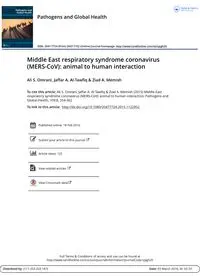
2015 Middle East respiratory syndrome coronavirus (MERS-CoV)_ animal to human interaction PDF
Preview 2015 Middle East respiratory syndrome coronavirus (MERS-CoV)_ animal to human interaction
Full Terms & Conditions of access and use can be found at http://www.tandfonline.com/action/journalInformation?journalCode=ypgh20 Download by: [117.253.203.147] Date: 03 March 2016, At: 02:33 Pathogens and Global Health ISSN: 2047-7724 (Print) 2047-7732 (Online) Journal homepage: http://www.tandfonline.com/loi/ypgh20 Middle East respiratory syndrome coronavirus (MERS-CoV): animal to human interaction Ali S. Omrani, Jaffar A. Al-Tawfiq & Ziad A. Memish To cite this article: Ali S. Omrani, Jaffar A. Al-Tawfiq & Ziad A. Memish (2015) Middle East respiratory syndrome coronavirus (MERS-CoV): animal to human interaction, Pathogens and Global Health, 109:8, 354-362 To link to this article: http://dx.doi.org/10.1080/20477724.2015.1122852 Published online: 18 Feb 2016. Submit your article to this journal Article views: 125 View related articles View Crossmark data 354 DOI 10.1080/20477724.2015.1122852 Pathogens and Global Health 2015 VOL. 109 NO. 8 © W. S. Maney & Son Ltd 2016 Review Middle East respiratory syndrome coronavirus (MERS-CoV): animal to human interaction Ali S. Omrani1, Jaffar A. Al-Tawfiq2,3, Ziad A. Memish4 1Department of Medicine, Section of Infectious Diseases, King Faisal Specialist Hospital and Research Centre, Riyadh, Saudi Arabia, 2Johns Hopkins Aramco Healthcare, Dhahran, Saudi Arabia, 3Indiana University School of Medicine, Indianapolis, IN, USA, 4Ministry of Health & College of Medicine, Alfaisal University, Riyadh, Saudi Arabia The Middle East respiratory syndrome coronavirus (MERS-CoV) is a novel enzootic betacoronavirus that was first described in September 2012. The clinical spectrum of MERS-CoV infection in humans ranges from an asymptomatic or mild respiratory illness to severe pneumonia and multi-organ failure; overall mortality is around 35.7%. Bats harbour several betacoronaviruses that are closely related to MERS-CoV but more research is needed to establish the relationship between bats and MERS-CoV. The seroprevalence of MERS-CoV antibodies is very high in dromedary camels in Eastern Africa and the Arabian Peninsula. MERS-CoV RNA and viable virus have been isolated from dromedary camels, including some with respiratory symptoms. Furthermore, near-identical strains of MERS-CoV have been isolated from epidemiologically linked humans and camels, confirming inter- transmission, most probably from camels to humans. Though inter-human spread within health care settings is responsible for the majority of reported MERS-CoV cases, the virus is incapable at present of causing sustained human-to-human transmission. Clusters can be readily controlled with implementation of appropriate infection control procedures. Phylogenetic and sequencing data strongly suggest that MERS-CoV originated from bat ancestors after undergoing a recombination event in the spike protein, possibly in dromedary camels in Africa, before its exportation to the Arabian Peninsula along the camel trading routes. MERS-CoV serosurveys are needed to investigate possible unrecognized human infections in Africa. Amongst the important measures to control MERS-CoV spread are strict regulation of camel movement, regular herd screening and isolation of infected camels, use of personal protective equipment by camel handlers and enforcing rules banning all consumption of unpasteurized camel milk and urine. Keywords: MERS-CoV, Coronavirus, Middle East, Animal, Dromedary, Camel, Bat, Zoonosis Introduction The Middle East respiratory syndrome coronavirus (MERS-CoV) was first isolated from a 60-year man who died in a hospital in Jeddah, Saudi Arabia, in June 2012 with severe pneumonia and multi-organ failure.1 Thus far, the majority of MERS-CoV cases have originated in coun- tries in the Middle East, including Saudi Arabia, the United Arab Emirates (UAE), Qatar, Oman, Kuwait and Iran.2 Clinical illness associated with MERS-CoV ranges from mild upper respiratory symptoms to fulminant pneumonia and multi-system failure.3−5 Human-to-human transmis- sion of MERS-CoV is well documented in family clus- ters, community settings and more often in health care settings.3,6–8 Larger hospital outbreaks have been driven by a combination of late recognition, over-crowding and inadequate infection control precautions.5,9,10 However, MERS-CoV inter-human transmissibility is thought to be relatively limited.11−13 Up to 12 August 2015, a total of 1401 laboratory-con- firmed MERS-CoV infections, including 500 associ- ated deaths, have been reported to the World Health Organization.14 As with many emerging viral infections, a zoonotic source was suspected soon after the identification of MERS-CoV.15 We herein review the available evidence that associates MERS-CoV with animal sources and the probable directions of transmission. Host Susceptibility MERS-CoV entry into their host cells is mediated by binding of a receptor-binding domain on their spike (S) proteins to specific cellular receptors known as dipeptidyl peptidase 4 (DPP4).16,17 DPP4 is expressed on the epithelial and endothelial cells of most human organs; an observa- tion that might explain the multi-system clinical spectrum Correspondence to: Ziad A. Memish, Ministry of Health & College of Medicine, Alfaisal University, P.O. Box 54146, Riyadh 11514, Kingdom of Saudi Arabia. Email:
